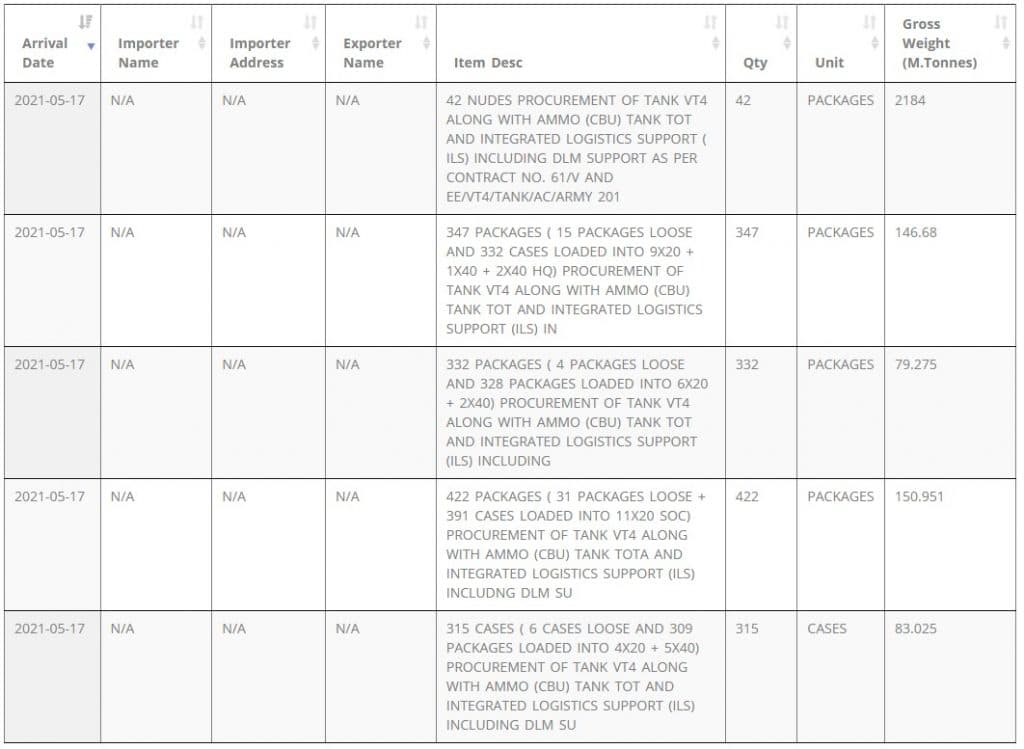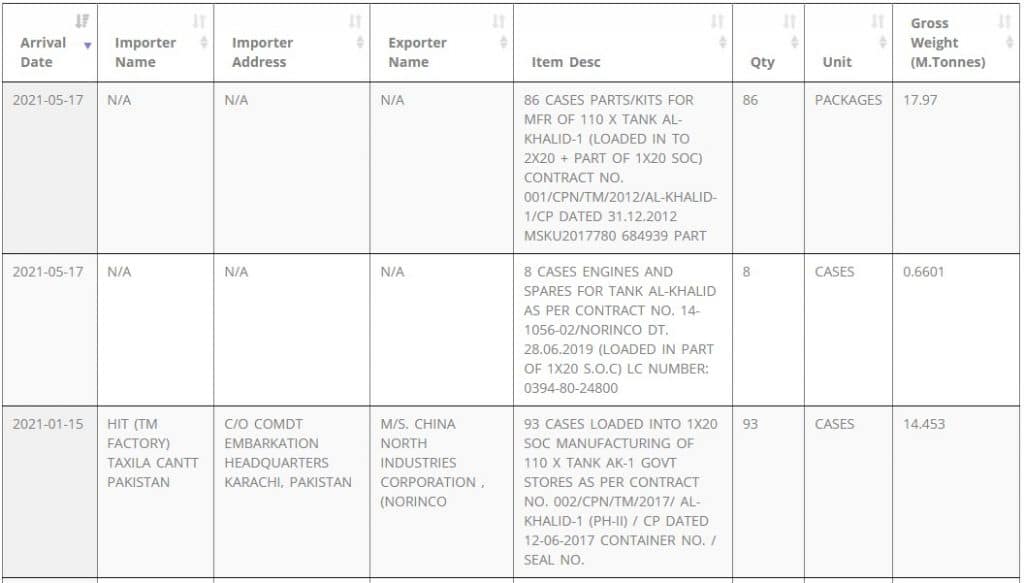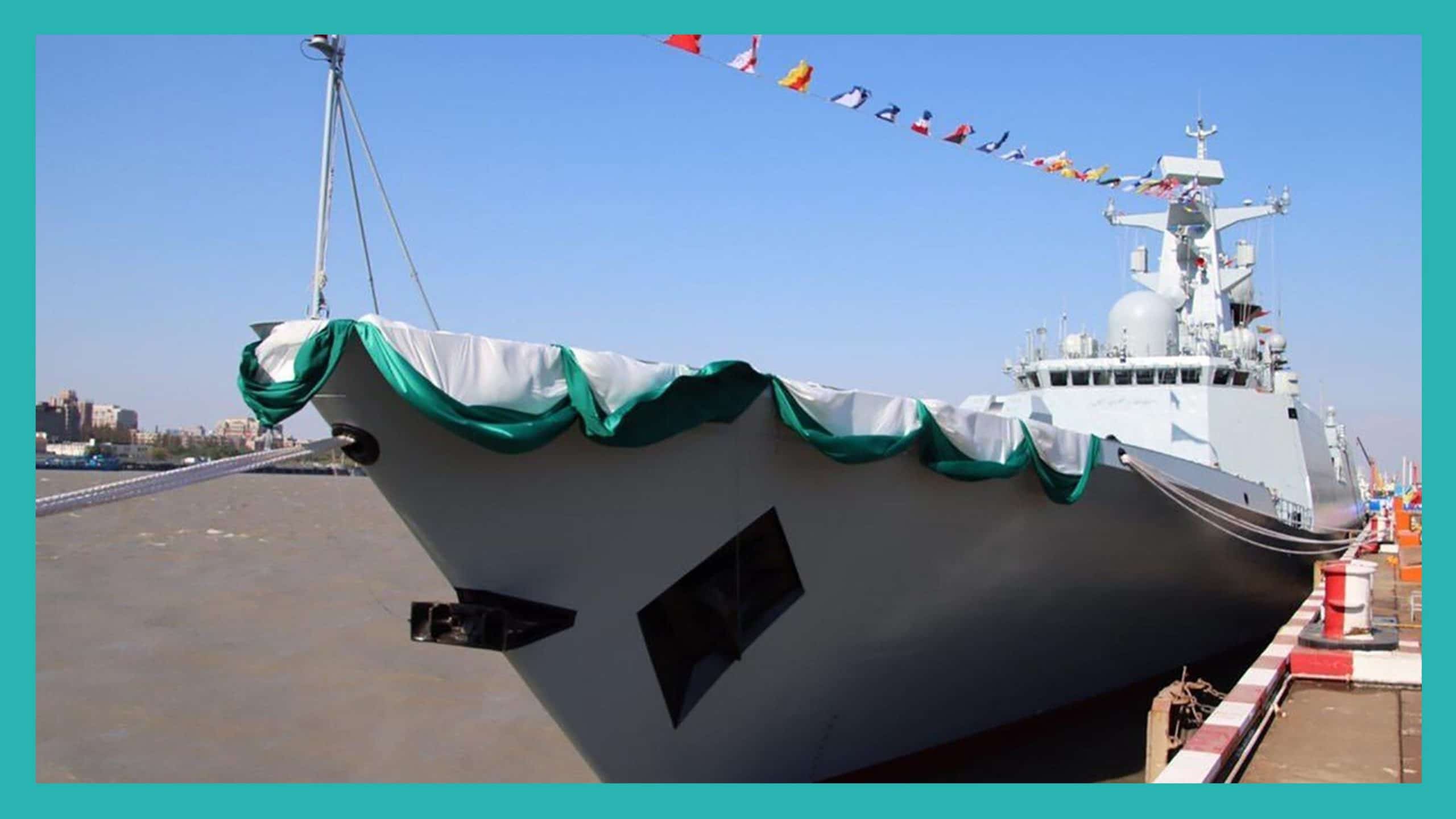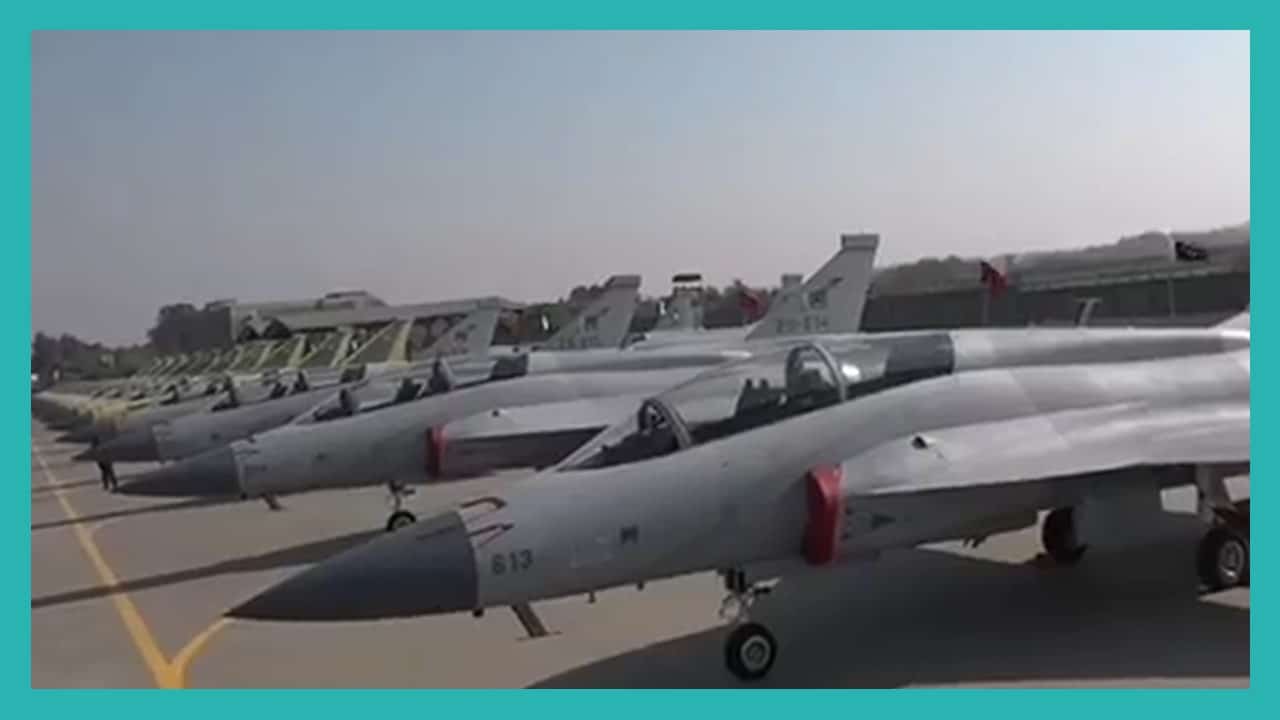1View 0Comments
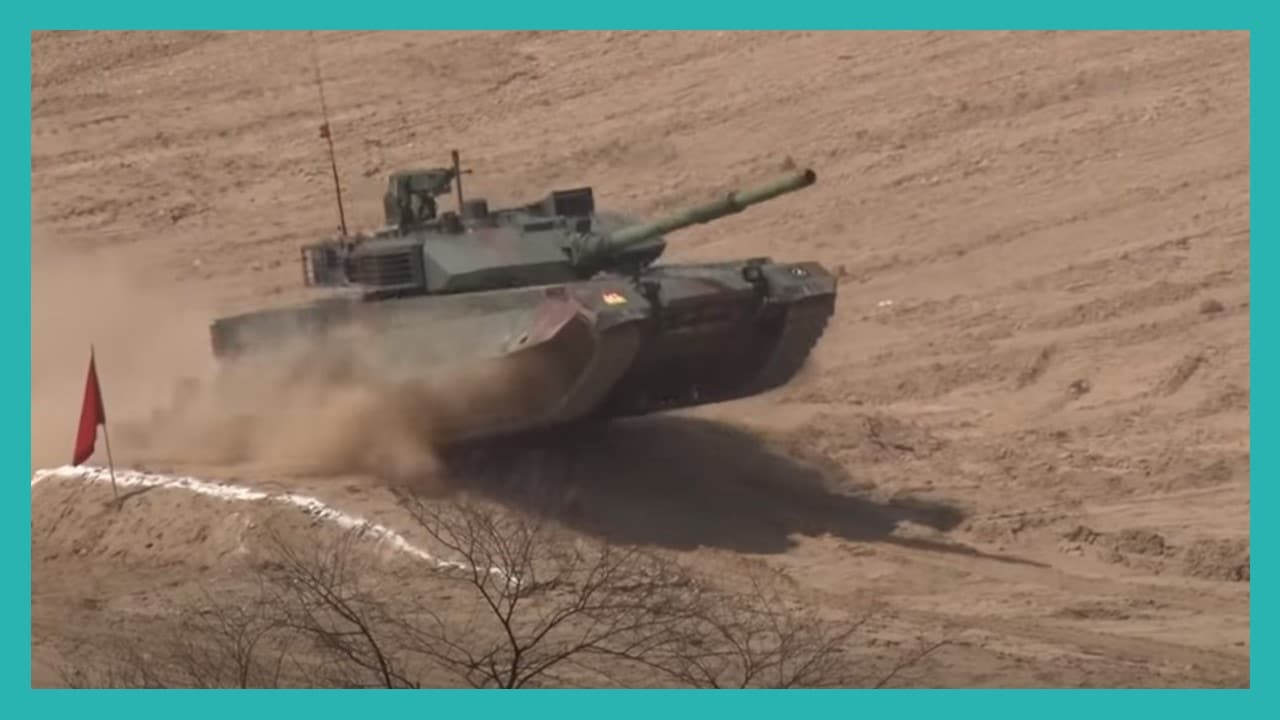
Pakistan Receives Additional VT4 and Al-Khalid-I Parts
In May 2021, Pakistan took delivery of both additional VT4 main battle tanks (MBT) and subassemblies or components for the al-Khalid Improved (al-Khalid I) from China’s Norinco Group. The information comes from publicly available import-export registries in Pakistan.
The Pakistan Army (PA) officially revealed the VT4 during a firing demonstration in October 2020. The PA had evaluated the VT4 as part of its Haider MBT program. The PA planned the Haider program as an off-the-shelf solution to accelerate its tank modernization efforts (alongside the al-Khalid-series).
Pakistan shortlisted the VT4 and the Kharkiv Morozov Machine Building Design Bureau (KMDB) Oplot-P, and ultimately, selected the VT4 in late 2018. According to sources, the PA has a $859 million U.S contract in place for 176 VT-4 tanks. Pakistan is considering additional batches.
In terms of the al-Khalid I, the PA currently has an order for 110 units in place with Heavy Industries Taxila (HIT). HIT delivered its most recent al-Khalid I batch to the PA in August 2020. Based on information from the Ministry of Defence Production (MoDP), HIT delivered 45 al-Khalid Is between 2015 and 2018.
Norinco Group has been delivering components for the al-Khalid I through 2020 and 2021. Based on these deliveries, it is possible that the PA will induct another batch of al-Khalid I MBTs in late 2021 or early 2022. Likewise, one can expect another VT4 induction announcement around that timeframe as well.
Developing a Next-Generation Tank
Neither HIT or the MoDP have offered new updates regarding the al-Khalid 2. The al-Khalid 2 is slated to be the most significant upgrade to the al-Khalid series to-date. Earlier reports had outlined that the new MBT could have a 1,500 hp engine (versus the 1,200 hp 6TD-2 of the al-Khalid I). In addition, Aselsan from Turkey offered its next-generation electronics package for the al-Khalid 2.
The induction of the VT4 adds new variables to the al-Khalid 2. Firstly, the PA committed a significant set of funds to acquiring the VT4 and inducting its various systems. It is possible that the PA could look to re-use some of the VT4’s systems in the al-Khalid 2. This would be a sensible step because it would develop a measure of commonality between the two tanks and, more importantly, the PA concluded that the VT4 would work in Pakistan’s strenuous operational conditions. Thus, if possible, the PA could try using those exact systems that it knows work in Pakistan in the al-Khalid 2.
These systems could potentially include the VT4’s critical components (e.g., transmission and engine), the electronics suite, remote-operated weapon system, main gun, active protection system (APS), or armour technology. However, HIT had been managing the design work for the al-Khalid 2 for years in advance of the VT4, so it is possible that HIT and the PA have finalized many of the most important subsystems.
Besides bringing the al-Khalid 2 into production, it will be interesting to see how HIT fares with sustaining its production through the long-term. To its credit, HIT recently underwent a modernization program that was aimed at introducing more automation to its processes. In 2017, HIT said that its modernization plans would allow it to manufacture equipment according to the “latest international standards.”
If these plans came to fruition, then HIT could potentially roll-out al-Khalid 2 units at its actual capacity of 50 tanks per year. This output would depend on the PA’s procurement roadmap and, ultimately, its annual budget. However, if the al-Khalid 2 is a high-performance machine (ostensibly on-par, if not superior to, the VT4), then one can expect the PA to lean on inducting it on a consistent cadence. Basically, a decade-long, full-capacity production run could result in 500 tanks, i.e., the bulk of the PA’s tank inventory.
There was a plan to introduce a new tracked infantry fighting vehicle (IFV) as well as a wheeled armoured fighting vehicle (AFV) to the armour inventory. However, it is unclear if these programs are still a priority.
During the 2018 International Defence Exhibition and Seminar (IDEAS), HIT had showcased the Viper, an enlarged and armed variant of the Talha-series of armoured personnel carriers (APC). However, the PA remained non-committal towards the HIT Viper. The benefit of the Viper is that it leverages HIT’s existing Talha/M113 production line, so adding it would not cost as much as an entirely new design. However, the Viper would still add valuable capabilities, such as anti-tank guided missiles (ATGM).
Likewise, Cavalier Group had showcased its Hamza AFV at both IDEAS 2016 and IDEAS 2018. But like the Viper, the PA remained non-committal towards the Hamza AFV. Earlier in the 2010s, the PA had evaluated the Chinese VN1 and Serbian Lazar. Like a new IFV, the PA had likely planned on a new AFV that can boost the anti-armour and anti-infantry fighting capabilities of its mechanized units.
Interestingly, the PA also had a 4×4 light armoured vehicle (LAV) bid. In addition to local designs (e.g., from Cavalier Group and HIT), South Korea’s KIA also proposed its Light Tactical Vehicle (LTV).
It is possible that the PA is opting to temporarily de-prioritize these programs in favour of accelerating its tank procurement. In fact, in addition to showing its focus on tanks, the PA is openly calling out its interest in modernizing its artillery as well. Besides revealing a new multi-launch rocket system (MLRS) in the form of the Fatah-1, the PA is apparently renewing its interest in various 155 mm/52-caliber howitzers.
Committing to Artillery Modernization
The PA Chief of Army Staff (COAS), General Qamar Javed Bajwa, reportedly announced that the Army is working to modernize its artillery.[1] The statement coincides with local reports of the Norinco SH15, Denel T5-52, and Yugoimport SDPR NORA-52 being present in Bahawalpur in recent weeks.
The context of the tests is unclear; they could be follow-up tests to the trials that took place in 2015-2016. Interestingly, the PA acquired 1,332 VLAP (very long-range artillery projectile) shells in 2017-2018. The PA may be testing these VLAP shells with these demonstrators.
The PA was expected to invest considerably in a new wheeled self-propelled howitzer (with analysts from IHS Markit estimating a spend of $844 million U.S). In 2017, a Serbian news outlet quoted Yugoimport-SDPR officials who said that the PA was seeking 500 units, of which Pakistan would build 400. Likewise, in September 2020, Denel Land Systems said that it was expecting strong interest in the T5-52.[2]
The PA may be thinking that modernizing its tank and artillery forces would deliver the most improvement in its offensive capability in the shortest amount of time. Thus, one could reasonably expect a contract for wheeled SPHs in late 2021 or early 2022. This program was in development since at least 2015.
In terms of supplier, the likeliest one is China. The PA was satisfied with the VT4, and it may find getting a credit line for SPHs easier from China than other suppliers. However, if the Army is parting with cash, then its purchase (be it from China, South Africa, or Serbia) would likely accompany an aggressive transfer-of-technology (ToT) package so as to manufacture most of the units domestically.
Besides wheeled SPHs, it will also be worth watching how the PA approaches tracked SPHs. It purchased 130 surplus M109Ls from Italy from 2017 to 2019. Leonardo has an upgrade package available for legacy M109 variants that would enable those SPHs to fire VLAP shells.[3] This upgrade could be a way for the PA to modernize its tracked SPH inventory relatively affordably (i.e., without acquiring another SPH system).
[1] “Pakistan army to modernise Artillery corps: COAS.” The Nation. 18 June 2021. URL: https://nation.com.pk/18-Jun-2021/pakistan-army-to-modernise-artillery-corps-coas
[2] “Denel sees strong potential for its T5-52 self-propelled howitzer.” Defence Web. 02 September 2020. URL: https://www.defenceweb.co.za/featured/denel-sees-strong-potential-for-its-t5-52-self-propelled-howitzer/
[3] Christopher F. Foss. “Leonardo testing upgraded M109L SP artillery system.” Jane’s Defence Weekly. 31 January 2019. URL: https://www.janes.com/defence-news/news-detail/leonardo-testing-upgraded-m109l-sp-artillery-system

